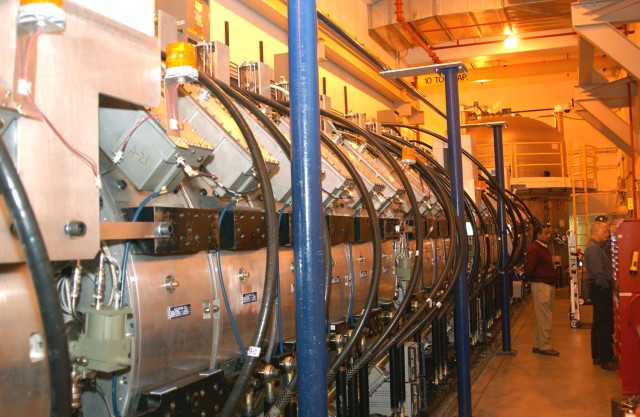The Dual Axis Radiographic Hydrodynamic Test (DARHT) facility has officially become "dual" with authorization to begin full power operations of Axis 2, adding both new capability and higher energy to the unique accelerator facility.
Los Alamos National Laboratory has received authorization from the National Nuclear Security Administration to begin operating Axis 2, an important diagnostic instrument that helps ensure the integrity of the nation's nuclear stockpile without nuclear testing. Scientists and engineers at DARHT can now begin test firings of the second axis electron beam as early as this week. The first truly dual axis hydrodynamic test should take place in early summer 2008.
"The achievement of this capability at DARHT is a major accomplishment in stockpile stewardship. Such tools assure the continued safety, security, and reliability of the nation's nuclear deterrent without the need to return to nuclear testing," said Glenn Mara, principal associate director for nuclear weapons programs. "Congratulations to the whole DARHT team for reaching this important and technically challenging goal."
DARHT consists of two electron accelerators positioned at a 90-degree angle, each focused on a single firing point. It is at this point where nuclear weapon mock-ups are driven to extreme temperatures and pressures with high explosives and where the DARHT electron beams produce high-energy X-rays used to image the behavior of materials and systems under those extreme conditions. Beginning in May of 2007 these experiments moved into fully contained in steel vessels, to better protect the environment and improve experiment turnaround time.
The technical demands of the second axis are one-of-a-kind -- a 17-million-volt electron beam lasting for 1.5 millionth of second, which is sliced into 4 pulses -- each lasting less than 100 billionths of a second-to create 4 X-ray pulses. These X-rays then create images of materials moving at 10,000 miles per hour with densities that exceed those at the center of the earth.
In December 2006, Laboratory managers called the four-pulse success a major collaborative achievement. Researchers from Lawrence Livermore National Laboratory worked with Los Alamos on developing an electromagnetic "kicker," which chops the long electron beam into four discreet, short pulses, as well as the unique target assembly specially designed to produce four pulses of X-rays modified to yield meaningful data during half-power firings. The primary purpose of these scaled accelerator tests is to understand the physics of the kicker and target to optimize the design to meet the project requirements and goals.
The DARHT second axis provides the nation with a unique, world-class scientific facility with the potential to not only provide four-frame "movies" of tests, but also to give scientists the data to create the first-ever three-dimensional images, critical data to meet the needs of the stockpile for decades to come.
Each Axis 2 cell is a 15,000-pound doughnut-shaped aluminum structure with an internal configuration of magnetic material and insulating oil. At the center of each cell is a high-voltage, vacuum-insulated beamline. The structures allow operators to add voltage in steps to an electron beam, accelerating it to very high energy and eventually slamming it into a dense target to create X-rays. Electronic detectors turn the X-rays into high-speed digital images of mock nuclear weapon components at detonation. Axis 2 consists of 74 individual accelerator cells.
Photos available at:
http://www.lanl.gov/news/albums/nuclear_sci/Cell_Refurbed_1.jpg
http://www.lanl.gov/news/albums/nuclear_sci/Cell_Refurb_2.jpg
http://www.lanl.gov/news/albums/nuclear_sci/DARHTaxis2.jpg
Los Alamos National Laboratory, a multidisciplinary research institution engaged in strategic science on behalf of national security, is operated by Los Alamos National Security, LLC, a team composed of Bechtel National, the University of California, The Babcock & Wilcox Company, and the Washington Division of URS for the Department of Energy's National Nuclear Security Administration.
Los Alamos enhances national security by ensuring the safety and reliability of the U.S. nuclear stockpile, developing technologies to reduce threats from weapons of mass destruction, and solving problems related to energy, environment, infrastructure, health, and global security concerns.

